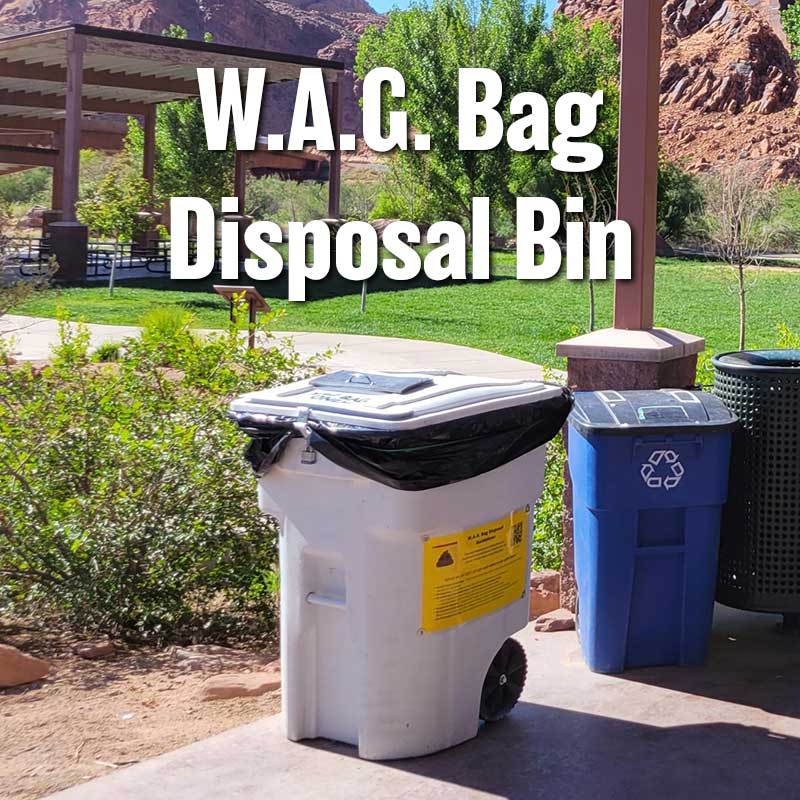Workers at the Canyonlands Solid Waste Authority can hopefully breathe a sigh of relief, as a multi-agency effort is trying to keep human fecal matter from unexpectedly flying at them.
In a pilot program this summer, five sites in Grand County and the City of Moab will have designated public Wag Bag Disposal cans.
Wag, for “waste alleviation and gelling,” bags are pre-made wrappers that can be used as portable toilets in remote areas, sealed, and packed out to avoid impacting the sensitive desert environment. Such bags are commonly available from backcountry outfitters, visitor centers at national parks, and are even distributed to hikers by Grand County Active Transportation & Trails workers.
However, once adventurers use these bags, the problem becomes how to dispose of them. When discarded in municipal garbage cans, sealed bags of waste can rupture when compacted by garbage trucks—leading to horror stories from solid waste workers. [See “Though landfill-safe, wag bags can’t be thrown in the garbage,” May 20, 2021 edition. -ed.]
Exploding wag bags or garbage bags of waste compressed in a garbage truck can “reach up to 6 to 7 feet,” noted Canyonlands Solid Waste Authority worker Ryan Cutting in a release about the initiative.
“If I get covered in human fecal matter, I’m going to be a sourpuss for the rest of the day,” said Cutting. “Even worse, I risk exposure to a laundry list of diseases and infections.”
Not only a terrifying thought, but it’s also a serious public health concern for workers and passersby, says officials with the Southeast Utah Health Department, which is sponsoring the program along with the Canyonlands Waste Authority, Grand County and the City of Moab.
“Finding a convenient and effective wag bag disposal solution is of the utmost importance to protecting the health and safety of CSWA staff while also addressing public health concerns related to human waste left on our public lands,” a health department statement reads.
Large containers will be placed on either side of the intersection of Highways 191 and 128 at Lions Park and the Grand County Transit Hub: one of the main locations for improperly disposed waste, according to workers.
“The main location with wag bags is the Transit Hub and the parks and some street cans next to the hotels,” commented Waste Authority worker Dante Haynes. “Poop is everywhere.”
The three other disposal locations are at Canyonlands Solid Waste Authority Transfer Station (2295 S. Highway 191), the Southeast Utah Health Department (575 Kane Creek), and the Wastewater Reclamation Facility (1070 W. 400 North). The bins are for non-commercial use, though the transfer station location also can accept waste from commercial tour operators during operating hours.
“This Wag Bag Disposal Site Pilot Program will be a work in progress,” said Arba Adams, Program Manager at Canyonlands Solid Waste Authority. “We will collect data and our working group will make recommendations in September based on quantitative and qualitative analysis. This is Phase One.”
While wag bag disposal is a start, solid waste workers report that “do-it-yourself waste disposal” from RVers or van life travelers using non-approved bags for human waste is an even thornier problem. Such bags are not permitted in Wag Bag Disposal sites: only sealed, spillproof wag bags should be discarded in the bins.
Ultimately, officials urge travelers and backcountry adventurers to try and use developed toilets for waste disposal whenever possible.
“We would like residents and visitors alike to know that a toilet is the best place to flush normal amounts of poop,” the press release advises.
Information on disposal sites, hours and rules will be available at Discover Moab’s new Poop in Moab page at www.discovermoab.com/poop.




